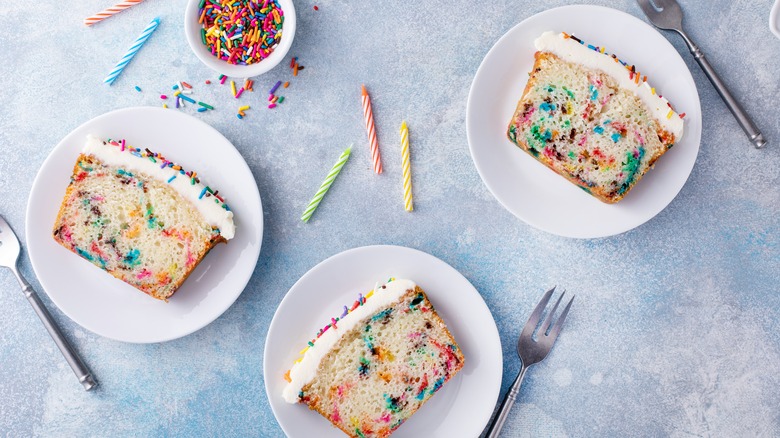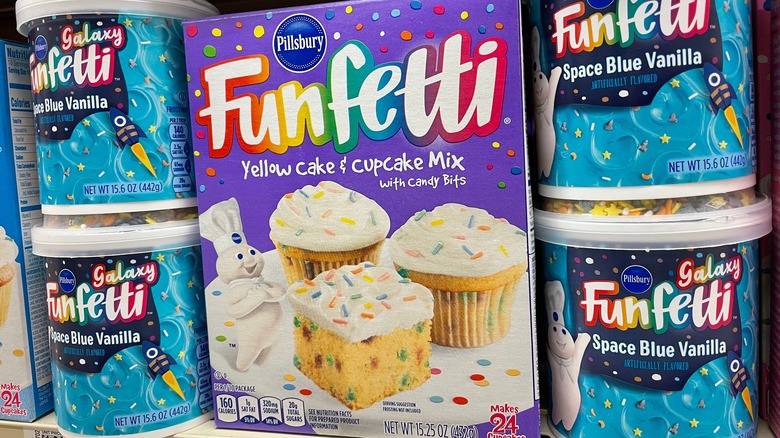What Does Birthday Cake Flavor Actually Mean?
The taste of birthday cake might be one of the most evocative sensory memories some of us have, and the flavor has proven so popular that it's made its way into everything from ice cream to protein bars; you can even buy cake-flavored vodka. But what is it about this taste that makes it so distinct? If you've ever wondered about what exactly birthday cake flavor is, you're not alone. The short answer is vanilla and sugar; a longer answer involves Proustian memory, white cake, butter, and rainbow sprinkles.
It's important to note that there is no industry standard birthday cake flavor. Some birthday cake flavoring is creamier than others, some are strictly vanilla, and others with a hint of almond or cherry. It's really up to the mysterious world of flavorists. For anyone inclined to take a peek behind the curtain, a common ingredient used to make birthday cake flavor is a chemical compound called diacetyl. This is a by-product of the fermentation process of alcoholic beverages that help impart a voluptuous, buttercream taste. Sweet, rich, and simple, the variable yet undeniably familiar flavor that is birthday cake has a decades-long history, and a special place in the hearts of kids and adults alike.
Funfetti sets the birthday cake standard
After the second world war, things like boxed cake mixes were created and became very popular with housewives of the mid-20th century due to their convenience and affordability. In the late 1970s, synthetic vanilla flavoring became more accessible than its natural forms of vanillin, which had normally been derived from things like cloves and pine bark, making it more common to see vanilla-forward sweets.
Thanks to the creation of the chemical vanillin, in 1989 Pillsbury unveiled maybe one of the most iconic box cake products of all time, the mother of birthday cake flavor: Funfetti. Though sprinkles have been around since the 18th century, Funfetti set a new standard, and is responsible for the synonymous relationship between birthday cake and sprinkles. Soon after, cake brands like Betty Crocker and Duncan Hines were producing their own colorful versions of Funfetti birthday cake boxed mixes.
Love for birthday cake stands the test of time
Over the following two decades, birthday cake became a snack food phenomenon. Kids from the '90s will remember the birthday cake-flavored Dunkaroos and Dannon Sprinkl'ins yogurt. In 2011, birthday cake got a grown-up twist with Beam Global Spirits & Wine's Pinnacle Cake Vodka. One year later, for its 100-year anniversary, Oreo released a birthday cake-flavored cookie. Within the year, 17 more birthday cake-flavored products debuted, including Good Humor ice cream and marshmallow Peeps.
As the Funfetti generation continues to get older, their nostalgic love for birthday cake's flavor and the feelings it evokes are finding new ways to evolve. Since 2017, as revealed by Nielsen, via Vox, birthday cake-flavored foods like jelly beans, pretzels, and protein bars, and cocktails have been up in sales by nearly 30%. Recently, even Kit Kat released a limited edition birthday cake candy bar.
Milk Bar carries on the birthday cake tradition with its iconic recipe
Founded in 2008 by James Beard Award-winning pastry chef Christina Tosi, Milk Bar created one of the most iconic birthday cakes since Pillsbury. Its signature, best-selling cake features layers of rainbow-flecked vanilla cake, creamy frosting with crumbs, and plenty of sprinkles. Not only has the cake become a viral trend, but it's also been replicated by at-home bakers, been featured on shows like "The Drew Barrymore Show" and "Extra TV," and helped lead Tosi's bakery to expand to 12 locations nationwide.
Tasting Table spoke to Anna McGorman, Milk Bar's VP of Culinary, about this iconic treat. "The Birthday Cake (soaked liberally with clear vanilla extract-spiked whole milk) is sprinkle-studded, fluffy and buttery," she explained. "The frosting is meant to drive a bit of tang (thanks to some cream cheese and sneaky amounts of buttermilk powder/citric acid) for balance, while the crumbs are there for texture and richness."
When developing the cake's flavor, McGorman noted, "One of the first places we looked was on the back of some Funfetti cake mix," adding, "It was crucial to understand where we (and the world at large) were starting from in order to then refine and reinterpret from there. Once we put all the ingredients on the table (literally and figuratively) it was a matter of bringing to life something new — deeper in nuance than the standard but still resonant to the core memories we all attached to this flavor from growing up."



